Discovering Albania's Most Significant Historic Sites: A Journey Through Time
- Alanna Gabbett

- Mar 17
- 19 min read
Updated: Mar 29
Albania, situated in the stunning Balkans, is a treasure trove of history and culture. Its rich past is showcased through beautiful landscapes and lively towns, making it an exciting destination for travelers. With roots tracing back to ancient civilizations, Albania boasts numerous historical sites brimming with stories. Many of these sites are recognized as UNESCO World Heritage Sites, highlighting their importance. This guide will take you through some of the must-see historical locations in Albania, detailing their significance, and offering practical tips for your visit.
"World Heritage is the designation for places on Earth that are of outstanding universal value to humanity and as such, have been inscribed on the World Heritage List to be protected for future generations to appreciate and enjoy." - Unesco.org
In this guide:
Bookmark these reads for later:
Exploring Albanian Delights: A Culinary Journey through the Flavors of Albania
When is the Best Time to Visit Albania? A Seasonal Guide for Travelers
To Rent or Not to Rent: Navigating Albania's Roads in a Rental Car
Affordable Destinations for Budget Travelers: Exploring 5 Eastern European Locations
How to Prepare for Your First International Adventure: Our Top Tips for New Explorers
Mastering the Art of Budget Travel: A Complete Guide to Planning an Affordable Vacation
The Ultimate International Flight Packing Checklist for Families: What You Can't Forget to Bring!
Unlocking the Best Travel Credit Cards: A Guide to Rewards, Benefits, and Perks
This blog may contain affiliate links. If you make a purchase through these links, I may receive a commission at no extra cost to you. I only share products and services that I personally trust and recommend. Thanks for supporting this site!
Butrint
The Ancient City by the Lake
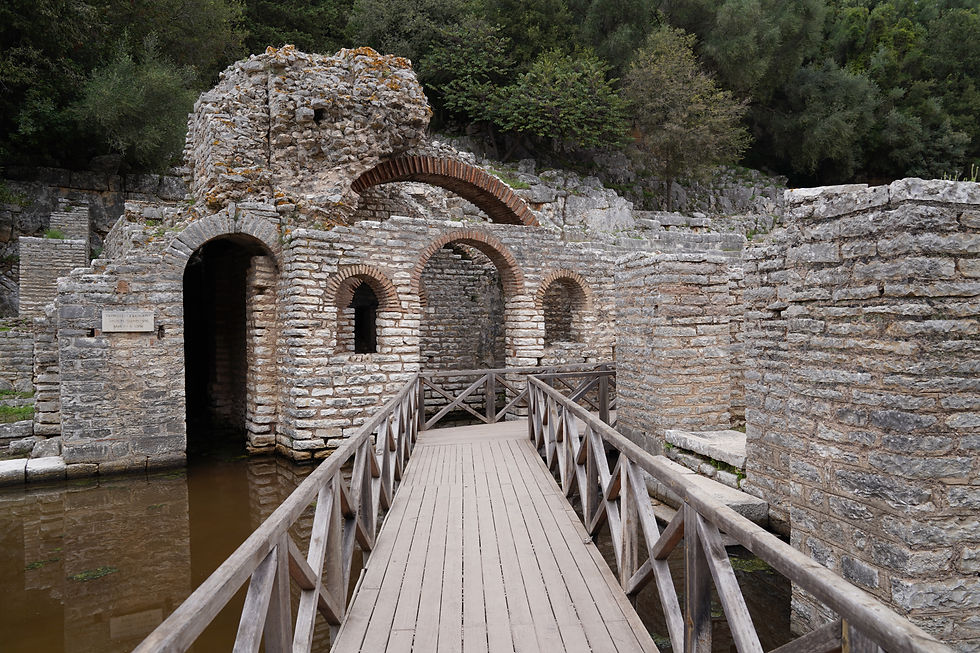
Butrint is one of Albania's most significant archaeological sites and a UNESCO World Heritage Site, located near the breathtaking Albanian Riviera. The city's history stretches back to the 8th century BC and reflects influences from the Greeks, Romans, and Byzantines.
To get to Butrint, it’s a straightforward 30-minute drive from the coastal town of Saranda. The entrance fee (as of 2024) is 1000 Albanian lek (approximately €10) per adult. The entry fee is paid in cash only and there is free parking on site. Arriving early is wise to explore the site before the crowds of tour groups arrive.
Combine your trip to Butrint with other popular attractions in the area:
Among the expansive ruins at Butrint, you will find a well-preserved Roman theater with seating for up to 1,500 spectators, a stunning Byzantine Basilica, and remains of an ancient aqueduct that showcases advanced engineering for its time. You'll also come across a castle, Roman forum, city walls and gates, and merchant houses. Structures within the city of Butrint were constructed in various time periods, spanning over 2500 years, demonstrating rule by many empires along the way. The lush landscape surrounding these ruins and the nearby lake enhance Butrint's charm. The best seasons to visit are spring and early autumn when you can enjoy mild weather and vibrant nature.
Key tip: Bring insect repellent!Historical Timeline of Butrint:
Foundation (8th century BC): Butrint's history dates back to the 8th century BC when it was likely founded by Greek settlers from the island of Corfu. It was initially a Greek colony and known as Buthrotum.
Greek Period: During the 4th and 3rd centuries BC, Butrint became an important city-state in the Greek world, developing cultural and religious significance. The city's temple and theater from this period reflect its prominence in Greek culture.
Roman Influence (2nd century BC): In the 2nd century BC, Butrint came under Roman control. It flourished during the Roman era and became a major port and commercial hub. The Romans expanded the city, building large baths, villas, and monumental structures like the Roman Theater.
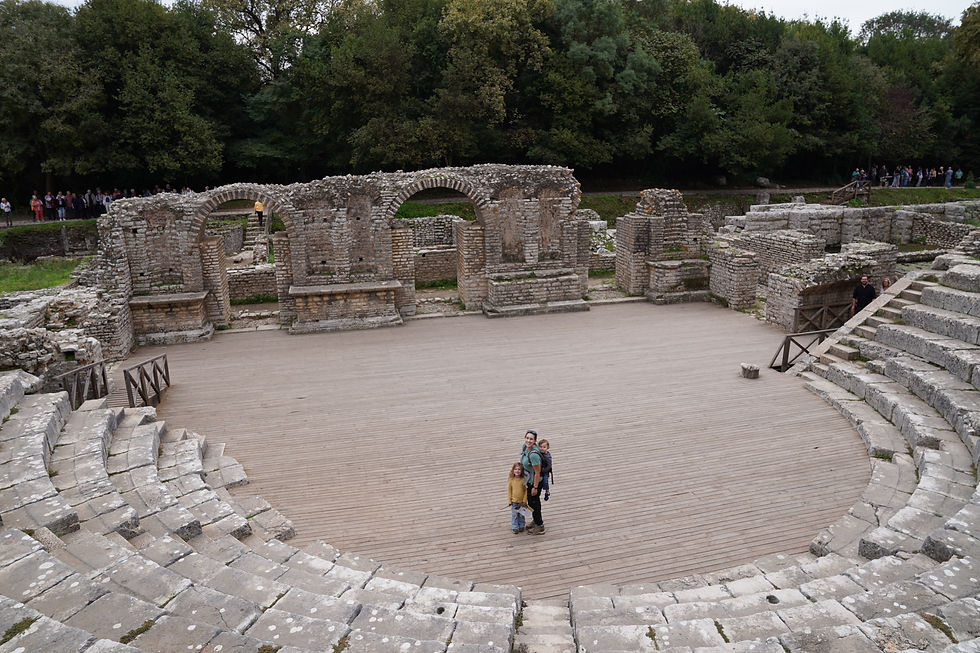
Byzantine Period (4th–12th centuries AD): After the fall of the Roman Empire, Butrint became part of the Byzantine Empire. During this period, the city was rebuilt and fortified, and many Christian structures were added, including the Baptistery with its stunning mosaics.

Venetian Rule (15th–17th centuries): In the 15th century, the Venetians took control of Butrint. They constructed fortifications and utilized the city for strategic purposes. Butrint's importance began to wane during this time, and the city gradually declined.
Ottoman Era (17th–19th centuries): By the time the Ottomans arrived, Butrint had largely been abandoned. It became a small, inconspicuous settlement, and its grand past faded into obscurity.
Early 20th Century: Butrint was rediscovered in the early 20th century by archaeologists, and excavations began to uncover the site's remarkable ruins. Its importance as a historical site was recognized by both the Albanian government and the international community.
UNESCO World Heritage Site (1992): In 1992, Butrint was designated a UNESCO World Heritage site, recognizing both its cultural and natural significance. The park today includes not only the archaeological ruins but also the surrounding wetlands and biodiversity.
Conservation and Tourism: Today, Butrint is a major tourist destination and an active archaeological site. The park is managed by the Butrint Foundation, which works to preserve and promote the site's unique heritage while also ensuring sustainable tourism.
Where to Stay:
Consider staying in the town of Ksamil, which is nearest to Butrint.
Gjirokastër
A Stone Town of Cultural Significance

Known as the "City of Stone," Gjirokastër is another significant UNESCO World Heritage Site in Albania, celebrated for its stunning Ottoman-era architecture. This town, located in the southern part of Albania, provides breathtaking views over the Drino River valley.
Traveling to Gjirokastër from Tirana takes around 3.5 to 4 hours by road. The entrance fee (as of 2024) to Gjirokastër Castle, one of the main attractions, is 400 lek (approximately $4). Children under 12 are free and payment is cash only. The castle is noteworthy for its thick stone walls and unique tower architecture.
If you're driving to Gjirokastër, you can find convenient and affordable parking HERE.When you arrive, take time to explore the cobblestone streets and beautiful bazaar area, selling authentic handicrafts, textiles, jewelry, and other souvenirs. You'll find so many wonderful places to shop, eat, and explore around the old town here. Visitors can explore the beautifully preserved Zekate House, a 19th-century mansion with stunning views, and the Ethnological Museum, which offers a glimpse into traditional Albanian life, while Skenduli House provides insight into Ottoman-era family life.
After exploring the old town, make the climb up to the impressive Castle of Gjirokastër.
Be cautious, as there are numerous stairs ascending to the castle, and they are quite uneven. Along the route, you'll encounter many vendors offering handmade goods and fruits for sale.
If you're not driving, consider one of these great day tours, combining other popular attractions in the area:
Gjirokastër Castle is one of the largest and most impressive fortresses in all of Albania, dominating the town and offering visitors a fascinating journey through history. Inside the castle, you can explore its ancient walls, towers, and fortifications, as well as enjoy stunning panoramic views of the town and the surrounding valley. The castle houses a museum showcasing artifacts related to Albania's military history, including old weapons, armor, and an exhibition on the country's communist era. A standout feature is the collection of large cannons, some of which are still intact, as well as the remains of a secret underground tunnel.

Historical Timeline of Gjirokastër:
Early Settlement: Gjirokastër’s history dates back to the Hellenistic period (4th–3rd century BC). The city was strategically located in the Zagori region in southern Albania, making it an important hub for the ancient Illyrians and later for Greek and Roman settlements.
Byzantine Era (6th–12th centuries): During the Byzantine period, Gjirokastër became a fortified town. The city’s castle, which overlooks the modern town, was built during this time and played a role in defending the region from invaders. The Byzantines also introduced Christian influences, with several churches built during this period.
Ottoman Conquest: Gjirokastër came under Ottoman rule in the late 15th century. The city became a significant administrative and cultural center in southern Albania. The Ottomans left a lasting impact on Gjirokastër's architecture, particularly its traditional stone houses, which are a hallmark of the city today.
Cultural Flourishing: Under Ottoman rule, Gjirokastër was known for its prosperous trade, especially in silk, and for its academic institutions. Many prominent Albanian families rose to prominence during this period, contributing to the city’s cultural heritage.
Resistance to Ottoman Rule: Gjirokastër was a focal point during Albania’s fight for independence from the Ottoman Empire. It was part of the broader movement for Albanian national identity and sovereignty in the late 19th and early 20th centuries.
Albanian Independence (1912): Gjirokastër played a role in Albania’s declaration of independence from the Ottoman Empire in 1912. It remained an important city throughout the early years of Albania’s new republic.
Socialist Influence: Under the communist regime of Enver Hoxha (who was born in Gjirokastër), the city underwent significant social and economic changes. Like much of the country, Gjirokastër became subject to heavy industrialization and ideological control. Despite this, the city’s historical architecture was largely preserved due to its location being less affected by industrial development.
UNESCO World Heritage Site: In 2005, Gjirokastër was inscribed as a UNESCO World Heritage site for its well-preserved Ottoman architecture and historical significance. The city is famous for its “stone town” appearance, with houses made of local stone that are characterized by steep, slate roofs.
Tourism and Preservation: Today, Gjirokastër is a popular tourist destination, attracting visitors with its historic castle, narrow cobblestone streets, and traditional homes. Efforts are ongoing to preserve the city’s unique heritage while developing its tourism infrastructure.
Late spring and early autumn are ideal for visits, ensuring pleasant weather for exploration.
Where to Stay:
Check out these centrally located accommodation options in Gjirokastër:
Berat
The City of a Thousand Windows
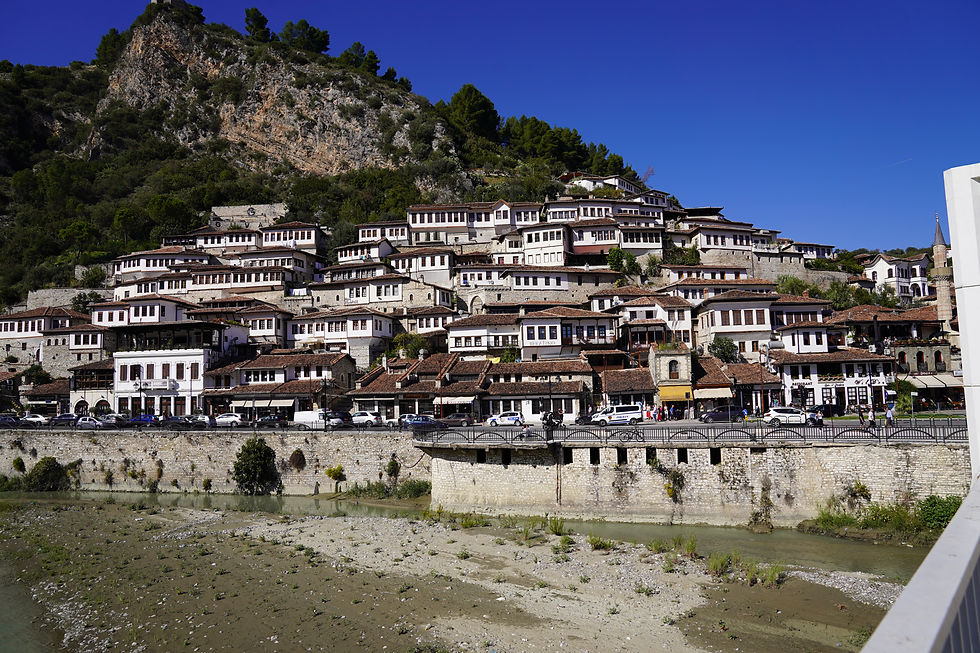
Berat, another UNESCO World Heritage Site, is famous for its blend of cultural and architectural styles. Known for its distinct Ottoman architecture and numerous windows, Berat sits at the base of Tomorr Mountain.
The journey from Tirana to Berat takes about 2 hours by car, making it an accessible stop. Once you arrive, either drive or walk up to the impressive Berat Castle, which offers sweeping views of the city and the picturesque Osum River. Inside the castle, explore ancient churches and even houses where some locals still reside.
Inside the castle walls, which are free to enter, you'll come across restaurants, guesthouses, ruins, observation decks, local vendors, and a heritage museum. Exploring all that Berat Castle has to offer will take about 2 hours at a leisurely pace. The main sites include Ruins of the Red Mosque, Holy Trinity Church, and the Main Viewing Platform.

Make your way back down to the center and wander through Berat's narrow streets, each adorned with charming, window-laden houses. The area is famous for wine production, so consider stopping at a winery to taste the local varieties. Take time to walk over Gorica Bridge or Ura e Varur. And don’t forget to stop by the Ethnographic Museum, located in a historic home, to gain insight into the region's cultural practices.
Historical Timeline of Berat:
Early Settlement: Berat's history dates back to ancient times, with evidence of settlements from the Illyrian period (around 4th century BC). The city was originally known as Antipatreia, believed to have been founded by King Antipater, a general of Alexander the Great. The ancient town was strategically located to control important trade routes along the Osum River.
Roman and Byzantine Eras: In the Roman period (2nd century BC–5th century AD), Berat became a significant urban center. After the fall of the Western Roman Empire, the town continued to flourish under the Byzantine Empire. It was during this period that Berat Castle was expanded, and Christian churches were constructed.
Ottoman Conquest: In 1417, Berat was captured by the Ottoman Empire and became an important administrative center. The Ottomans made substantial contributions to the city’s architecture, especially with the construction of mosques, baths, and bridges. The most famous Ottoman structure in Berat is the King Mosque, built in the 16th century, along with the Lead Mosque and Bachelors' Mosque.
Religious Harmony: During Ottoman rule, Berat became known for its unique coexistence of different religious communities. The city had a significant population of Muslims (both Albanians and Turks), but also a vibrant community of Orthodox Christians and Catholics. This cultural and religious diversity is reflected in the city’s architecture, with mosques, churches, and a synagogue all standing side by side.
Economic Prosperity: Under the Ottomans, Berat prospered economically due to its strategic location and thriving local industries, including silk production, handicrafts, and agriculture.
Albanian Independence: Following Albania's declaration of independence from the Ottoman Empire in 1912, Berat became part of the newly established Albanian state. The city, however, struggled with political instability and economic difficulties in the early 20th century.
Communist Era (1946–1991): Like many parts of Albania, Berat underwent significant changes during the communist era. The communist government, led by Enver Hoxha, implemented industrialization and collectivization policies, which impacted the city's traditional way of life. However, Berat's historical architecture was largely preserved due to its location being somewhat less affected by industrial development.
UNESCO World Heritage Site: In 2008, Berat was designated a UNESCO World Heritage site for its outstanding Ottoman-era architecture, particularly its well-preserved Ottoman houses, castles, and mosques. The city is often called the "City of a Thousand Windows" because of the distinctive appearance of its traditional homes, many of which feature large windows and are built into the hillsides.
Tourism and Preservation: Today, Berat is a major tourist destination, attracting visitors with its unique architecture, history, and natural beauty. Efforts are being made to preserve its historic sites while promoting sustainable tourism.
Spring and fall are the best times to visit, providing mild temperatures and fewer tourists.
Where to Stay:
Here are a few accommodation options in Berat, all under USD $100/night:
Berat City Panorama 1 **where we stayed - HIGHLY recommend
Apollonia
The Ruins of an Ancient Greek City

Apollonia Archaeological Park, located near the village of Pojan in Southern Albania, is a key player in Albania’s archaeological history. Founded in the 6th century BC, it was once a prosperous Greek city and an important trade center during the Roman Empire. Apollonia was once a thriving city of the Illyrian and Greek civilizations, later becoming an important Roman colony. It was renowned for its strategic location along the Via Egnatia, the Roman road that connected the Adriatic to the Byzantine Empire.
Though NOT a UNESCO World Heritage Site yet, there has been submission of Apollonia to the tentative site inclusion list, noting the exceptionally intact nature of the structures contained in the ancient city ruins. The site boasts several well-preserved ruins, including a Theater, the Temple of Apollo, a Basilica, and Roman baths, all surrounded by picturesque landscapes. The Apollonia Archaeological Museum, housed in a restored monastery, displays artifacts from the site, providing insight into its rich history.
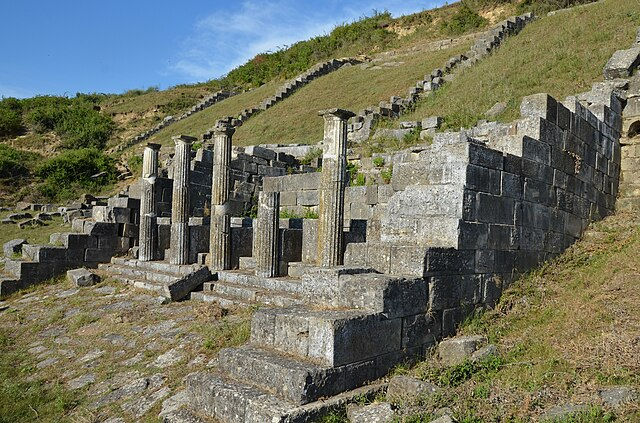
Parking on site is free and entry to the site costs 600 lek per adult (as of 2024), making it an affordable and accessible visit. To get to Apollonia, visitors can travel by bus or car from Tirana, the capital, which is about 2 hours away.
The parking lot can be found HERE.Surrounded by peaceful landscapes, Apollonia offers the perfect setting for a leisurely day trip. Visiting in spring or fall will reward you with comfortable weather and scenic views. The combination of ancient ruins, a peaceful setting, and fascinating history make Apollonia a must-visit for travelers seeking to dive deeper into Albania’s past.
Historical Timeline of Apollonia:
Foundation (6th Century BC): Apollonia was founded in the 6th century BC by Greek settlers from the island of Corfu. The city was named after Apollo, the Greek god of music, arts, and prophecy, reflecting its religious importance. It was strategically situated along the Via Egnatia, a key Roman road that connected the Adriatic coast to Byzantium (modern-day Istanbul).
Greek and Illyrian Influence: During its early years, Apollonia flourished as a Greek colony and became an important center of culture and trade. It was also influenced by the surrounding Illyrian tribes. The city developed significant infrastructure, including a theater and temples.
Roman Colony (2nd Century BC): By the 2nd century BC, Apollonia became a Roman colony under the rule of the Roman Republic. The city continued to grow in importance during the Roman period, benefiting from its location along vital trade routes. The Romans expanded the city’s infrastructure, building monumental structures such as the Agora, a basilica, and public baths.
Prominence and Decline: Apollonia was a flourishing city during the Roman Empire, but its importance started to wane in the 3rd century AD, particularly after the fall of the Western Roman Empire. The city faced several invasions and natural disasters, which contributed to its decline.
Byzantine Influence: After the fall of the Roman Empire, Apollonia continued to be inhabited during the Byzantine period. However, by the 6th century AD, the city had begun to lose its prominence as the political and economic center of the region shifted.
Medieval Period: By the Middle Ages, Apollonia had largely been abandoned. The area became overgrown, and the city’s ruins were left to the elements. Over time, the surrounding marshlands and shifting river courses further isolated the city.
Rediscovery (18th Century): Apollonia was rediscovered in the 18th century, though it wasn’t until the 19th century that significant excavations began. Archaeologists started unearthing the site’s important ruins, including the city walls, the theater, and various public buildings.
Archaeological Site Today: Today, Apollonia is a major archaeological park, open to the public. The ruins offer a rich glimpse into the past, with remnants from the Greek, Roman, and Byzantine periods. The site also includes the Apollonia Archaeological Museum, which houses artifacts from the city’s long history.
Where to Stay:
The closest place to stay the night before your Apollonia exploration would be the town of Fier, which is only about a 15-minute drive away. Here are some options for accommodation in Fier:
Krujë
The Stronghold of Skanderbeg
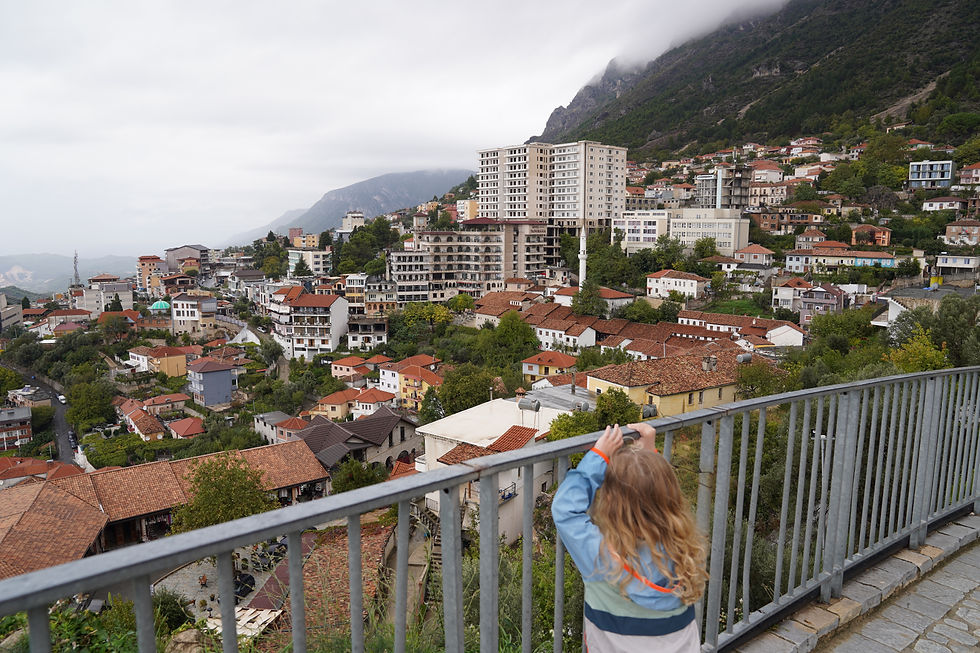
Krujë is a town steeped in history, closely tied to Albania's national hero, Skanderbeg, who led the resistance against the Ottoman Empire in the 15th century. The iconic Krujë Castle has played a vital role in defending against Ottoman invasions and stands proudly overlooking the town. The town is just 30 kilometers north of Tirana, easily accessible by car or public transport. If driving, consider this parking lot located in the center.
Entry to the Kruja Castle grounds is free (as of 2024), however, there is a fee of 500 lek per adult if you want to enter the Skanderbeg Museum.Kruja is also home to the Old Bazaar, a charming area filled with cobblestone streets, traditional shops, and local crafts, making it a popular destination for tourists seeking to experience authentic Albanian culture. This bazaar is one of the oldest in Albania, spanning back about 400 years! As you stroll through the historic bazaar, you can find unique handicrafts and souvenirs, such as traditional woven rugs, children's toys, clothing, and jewelry, as well as traditional souvenirs like magnets and postcards.

The town has been a key center for Albanian identity and resistance throughout history, and today it remains a symbol of national pride. With its blend of historical landmarks, natural beauty, and vibrant culture, Kruja is a must-visit destination for those exploring Albania’s heritage.
Historical Timeline of Kruja:
Illyrian Origins: Kruja’s history dates back to the Illyrian period (around the 3rd century BC). The region was inhabited by the Illyrians, an ancient Indo-European people. The strategic location of Kruja, perched on a hill with views of the surrounding valleys, made it an ideal site for defense and settlement.
Roman and Byzantine Eras: Kruja continued to be an important settlement under the Romans and later the Byzantines. Its location on trade routes linking the Adriatic coast with the interior made it valuable for both economic and military reasons. During this time, the Kruja Fortress began to take shape, eventually becoming the city's focal point.
Ottoman Conquest (15th century): Kruja came under the control of the Ottoman Empire in the 15th century. However, the city gained lasting fame due to the leadership of Skanderbeg, a nobleman from the Kastrioti family.
Skanderbeg’s Revolt (1443–1468): Skanderbeg is the central figure in Kruja’s history. After fighting for the Ottomans, he turned against them and led a resistance in Albania. Kruja became the headquarters of his resistance, and Skanderbeg's fortress in the city was instrumental in holding off Ottoman forces. Throughout his campaign, he successfully resisted several Ottoman sieges. His leadership made Kruja a symbol of Albanian resistance and pride.
The Siege of Kruja (1466–1478): Kruja withstood several Ottoman sieges during Skanderbeg's lifetime. The most notable siege came in 1466 and continued after his death in 1468. The city finally fell to the Ottomans in 1478, marking the end of Skanderbeg’s resistance. After the fall, Kruja was absorbed into the Ottoman Empire, and much of its defensive structures were reinforced by the Ottomans.
Ottoman Rule: Under Ottoman rule, Kruja continued to be an important administrative and military center. The Ottomans built mosques, bathhouses, and other structures, but the city’s strategic importance gradually diminished as the empire’s power shifted to other areas.
Cultural and Religious Diversity: Like many parts of Albania during the Ottoman era, Kruja saw the rise of both Muslim and Christian communities. The city’s fortress, however, remained a symbol of the national identity and resistance, particularly to Albanians.
Early 20th Century: Kruja was involved in Albania's fight for independence from the Ottoman Empire in 1912. During the Balkan Wars (1912-1913) and World War I, the city experienced political instability, like much of Albania.
Communist Period (1946–1991): Like many other parts of Albania, Kruja was affected by the communist regime of Enver Hoxha. During this time, many of the country’s historical sites were neglected or repurposed, and the focus was on industrialization and socialist ideology.
Tourism and Restoration: After the fall of communism, Kruja saw a resurgence of interest in its history and heritage. The city has become an important tourist destination, especially because of its connection to Skanderbeg. The Skanderbeg Museum (in the old fortress) and the Ethnographic Museum are major attractions. Restoration work on the Kruja Fortress and the old bazaar has been carried out to preserve the city’s unique architecture and cultural heritage.
UNESCO Tentative List: Kruja is a part of the UNESCO Tentative List for World Heritage status, highlighting its significance as a historic center of Albanian identity and resistance.
Where to Stay:
The center of Kruje is very walkable and full of charming shops and cafes to explore. Alternatively, you could choose to stay in the capital city of Tirana, which is only an hour's drive away or easily reached by public transport. Here are some options in the center of Kruja:
Rozafa Castle
The Legend of the Fortress

Rozafa Castle, located on a hill above Shkodra, presents stunning views and a captivating legend. According to folklore, the castle was built by three brothers who could only complete it by sacrificing their sister, Rozafa, who was entombed in the walls.
Called "the legend of the woman in the wall," according to local folklore, the castle was being built by three brothers who discovered that every night the walls they constructed would mysteriously collapse. A wise man told them that the only way to keep the walls standing was to sacrifice a living person. The youngest brother’s wife, Rozafa, volunteered to be walled in alive. She requested that one of her breasts, one of her eyes, and one of her feet remain outside the wall so she could nurse her child, see her family, and move. The brothers agreed, and thus, Rozafa was walled into the castle, her body becoming part of its structure. The story of Rozafa’s sacrifice has become one of Albania's most enduring legends, symbolizing themes of loyalty, sacrifice, and endurance.
You can easily access Rozafa Castle from Shkodra, which is about a 2-hour drive from Tirana. The entrance fee (as of 2024) is roughly 400 lek per adult, with children under 12 being free. Payment is cash only. Visitors can explore the impressive ruins while enjoying panoramic vistas of surrounding lakes and mountains.

Additionally, Rozafa Castle houses a small museum that details its long history. The optimal time for a visit is late spring or early autumn, when the temperatures are pleasant, and the scenery surrounding the castle is at its best.
There is a small parking lot at the entrance of the castle, or you could park at the bottom and walk up like we did. The road leading to the top is narrow and winding. We parked on the side of the road HERE for free.Rozafa Castle is a symbol of Albania’s rich cultural heritage, its complex history of occupation, and its legends that continue to be passed down through generations. It serves not only as an architectural and historical landmark but also as a cultural and national symbol of sacrifice, strength, and resilience.
Historical Timeline of Rozafa Castle:
Illyrian Roots: The first known settlement on the site of Rozafa Castle dates back to the Illyrian period, around the 4th century BC. The Illyrians were an ancient group of tribes that inhabited much of the western Balkans, including modern-day Albania. The castle was likely used as a fortress for the local Illyrian tribes, given its strategic position.
Roman and Byzantine Influence: During the Roman Empire, the castle’s strategic location continued to be of importance. It was further fortified and used as a military stronghold. After the fall of the Roman Empire, the castle remained in use throughout the Byzantine period as part of the region’s defense network against invaders.
Venetian Rule (14th–17th centuries): In the medieval period, especially during the 14th century, Rozafa Castle came under Venetian control. The Venetians made significant upgrades to the castle, expanding and reinforcing its walls to secure their dominion over the area. The castle was of great strategic value as it controlled the entrance to the Buna River and the routes to the Adriatic Sea.
Ottoman Period (15th–19th centuries): Following the Ottoman conquest of Albania in the late 15th century, Rozafa Castle fell into Ottoman hands in 1479. Under Ottoman rule, the castle continued to serve as an important military and administrative center for the region. However, the Ottomans did not significantly alter its structure, and it retained much of its medieval design.
Decline and Preservation: After the Ottomans left Albania in the late 19th century, the castle fell into a state of disrepair. The site, while still recognized for its historical significance, was largely abandoned until the 20th century, when archaeological and restoration efforts began.
Tourism and Archaeological Site: Today, Rozafa Castle is a major tourist destination in Albania. Visitors can explore its ancient ruins, the well-preserved walls and towers, and enjoy breathtaking views of Shkodër, Lake Shkodra, and the surrounding countryside. The castle also houses a small museum, displaying artifacts from its long history, including items from the Illyrian, Roman, Byzantine, Venetian, and Ottoman periods.
Where to Stay:
Shkoder is one of the largest and oldest cities in Albania and the center is easily walkable, with many local shops, restaurants, and cafes to try, and just a short distance to Rozafa Castle. Consider one of these options in the city center:
Albania’s historical sites are a gateway to understanding the country’s rich and diverse heritage. From the ancient ruins of Butrint and Apollonia to the charming streets of Gjirokastër and Berat, every destination has a unique story to share. The castles and museums provide valuable insights into the triumphs and challenges that have shaped Albania over the centuries.
For those eager to discover history, these sites offer more than just glimpses into the past. They present a connection to the vibrant present of Albania. As you plan your adventure through this stunning country, consider visiting these significant locations to truly immerse yourself in Albania’s cultural richness and historical significance. Whether you are a passionate historian, an eager traveler, or simply in search of adventure, you will find Albania’s historical treasures are waiting for you to explore.








Comments